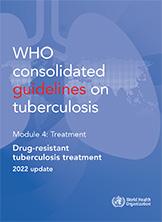4.2.6 Discontinuation of the regimen
The BPaLM/BPaL regimen may need to be discontinued in some patients. In such cases, patients need to be evaluated and treatment switched to an individualized longer regimen, based on the WHO guidelines for regimen design using priority grouping of medicines. The most common situations in which the regimen may be discontinued are treatment failure, inability to use linezolid for enough time owing to adverse effects (discussed above) or pregnancy that occurs during treatment.
 Feedback
Feedback
